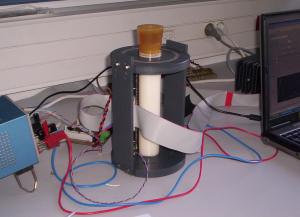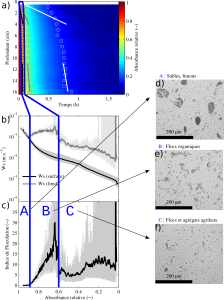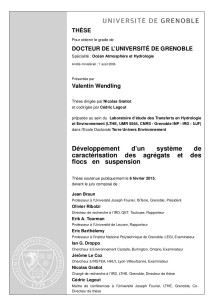Thesis defended February the 6th, 2015, Laboratoire d’étude des Transferts en Hydrologie et Environnement Supervisors : Nicolas Gratiot and Cédric Legout.
Abstract
Little is known about the processes that govern the evolution of suspended particle characteristics during their transport through a river basin. This is a main limitation for modelling erosion severity or suspended solids (SS) fluxes. It also leads to difficulties to propose management policies adapted to environmental legislation. Based on experiments in controlled environments, we have shown that soil particles tend to disaggregate in turbulent flows. The increase in SS concentration was associated to an increase of the disaggregation of SS particles, leading to smaller final particle sizes. Laboratory experiments also showed that the variability of the particle sizes due to their evolution over one hour was smaller than the variability due to the soil type from which the particles originated. However it is important to ensure that the suspended particles behave in the same way in natural conditions, where complex interactions between hydraulic, chemical and biological processes can influence their evolution. Up to now no measurement method allows measuring continuously the suspended sediment properties in highly concentrated fluids (from one to hundreds grams per liter), such as those observed in headwater catchments during runoff events. This severely limits the possibility to identify the processes that are important to consider in numerical models. The Aggregate and Floc Characterization System (SCAF) has been developed in order to measure SS properties for a wide range of SS concentrations. It was designed to be easily incorporated into sequential samplers. Immediately after the collection of a sample from the river, the sedimentation of the suspension is recorded by continuous measurements of the absorbance by a series of optical sensors. A method was proposed to processes the raw optical data in order to obtain the settling velocity distribution of the suspension. It also provides a flocculation index representing the tendency of the particles to flocculate during their sedimentation. The calculated settling velocity distributions were validated on a large range of materials and settling regimes in order to cover the natural variability of suspended sediments. For sediments that hardly flocculate during their sedimentation or are non-cohesive, the measurements of the SCAF were similar to those from other methods. In the case of suspensions that strongly flocculate during sedimentation, most of the classical methods give non-representative falling velocities. In this case, the optical property of the particles may vary during settling, affecting the optical measurement. The proposed method allowed quantifying the increase of settling velocity induced by flocculation, and provided confidence intervals for the settling velocities. For high SS concentrations ( > 10 g/l), a settling front can be formed during the sedimentation, which is well characterized by the SCAF. The measurement of the settling velocity distributions and of the flocculation index can be used to identify different particle populations (sand grains, flocs, individual particles) forming a suspension. Monitoring these properties in watersheds offers new insights to explore sediment connectivity within river basins and to optimize water management strategies




